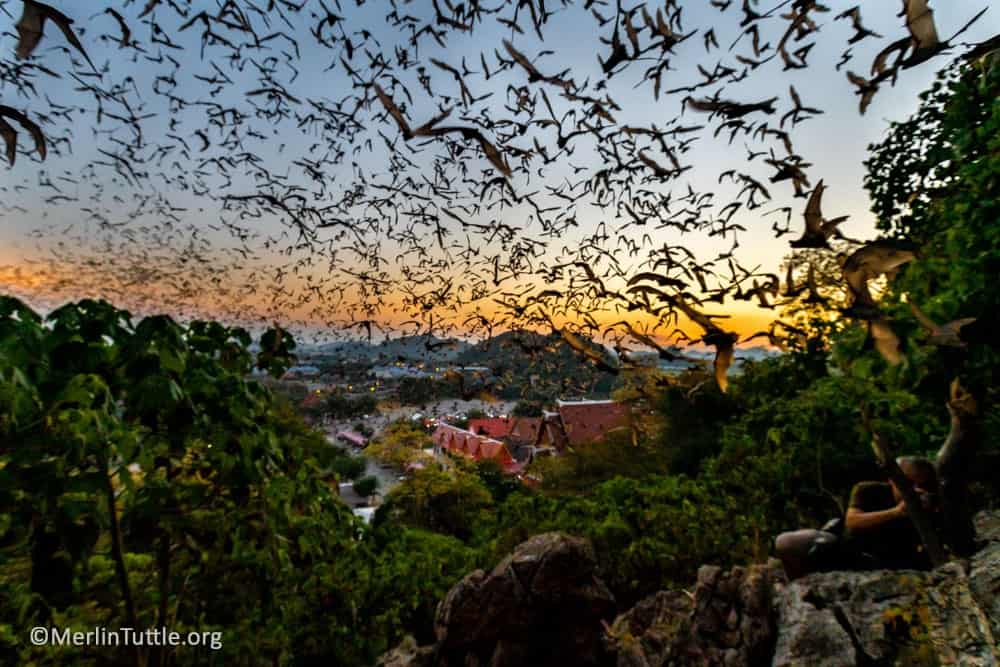Challenging torrential rains countered by cooperative bats in Costa Rica
Merlin and MTBC team members spent 19 days in Costa Rica last November on a filming trip for “Bat City” with its Director and Emmy
Wrong approaches in defense of bats can be even worse than not defending them at all. Articles, such as the one published in the May 15 issue of Scientific American, “Bats are Not Our Enemies,” are meant to defend bats, but can unwittingly perpetuate needless fear and intolerance. As experience has shown, despite good intentions, nothing can threaten bats more than fear.
The article’s subheading, “The viruses they carry spill over into humans mostly when we encroach on their territory or drag them into ours—and bats do great good as well” does nothing to quell fear. Readers should be wary of praising articles that include misleading statements about disease or ones that promote separation from bats as a solution.
Without putting disease risks in perspective, simply stating the value of bats cannot counteract the belief that bats are dangerous sources of deadly diseases, capable of threatening one’s family. People will always prioritize their own well-being rather than protect animals they fear. A study, currently in press, surveyed people on their willingness to support bat conservation. Support improved significantly only when fear was eliminated.

The study on which most media reports are based was clearly biased, claiming that bats harbor more viruses than other animals. It compared just 4 of the 26 orders of mammals and sampled nearly twice as many bats as all other mammals combined. Since new viruses can be found anywhere, a disproportionate search can be misleading. A far more thorough study recently concluded that bat species harbor no more viruses than other mammals or even birds, though it’s received very little media attention.
The recently promoted idea of restricting bats to protected areas is impractical and impossible to implement. As human populations expand, there is increasing need to share habitats. Even huge bat colonies can be safe neighbors, as demonstrated in cities like Austin, Texas. In fact, humans can benefit greatly. How can bats protect us from pests, pollinate crops, or generate tourist revenue if excluded from our farms and neighborhoods?
Limiting habitat destruction is critical to preserving biodiversity and ensuring the survival of many species. However, it’s imperative that we learn to live harmoniously with wildlife wherever possible. Bat survival increasingly demands that we not only protect their natural habitat but share ours as well.
There is no documentation that Ebola, SARS, MERS, Hendra, or COVID-19 have ever been transmitted from bats to humans, though bats are often presented as the source of human infection. Such diseases are also often mentioned as though they are widespread, without admitting that they (excluding COVID-19, of course) are rare or limited to specific geographic areas. Nevertheless, bats still have one of our planet’s finest records of living safely with humans.
For anyone who simply doesn’t handle bats, the risk of contracting a disease from one is extremely remote.
Please use these resources and citations to share the truth about bats as safe and valuable neighbors.
(Last updated March 2021)
Love our content? Support us by sharing it!
Merlin and MTBC team members spent 19 days in Costa Rica last November on a filming trip for “Bat City” with its Director and Emmy
“Just like the old days, eh Heather?” Kent softly clicks his tally counter as he sits in his folding chair on the other side of
Bats can use sounds in many complex ways. They can sing and even have different dialects… When imagining a bat, the first thoughts that come
It was a long road to Austin, Texas. More than five years after my first introduction to Merlin Tuttle’s Bat Conservation as a teenager, I packed
2024 © Merlin Tuttle’s Bat Conservation. All rights reserved.
Madelline Mathis has a degree in environmental studies from Rollins College and a passion for wildlife conservation. She is an outstanding nature photographer who has worked extensively with Merlin and other MTBC staff studying and photographing bats in Mozambique, Cuba, Costa Rica, and Texas. Following college graduation, she was employed as an environmental specialist for the Florida Department of Environmental Protection. She subsequently founded the Florida chapter of the International DarkSky Association and currently serves on the board of DarkSky Texas. She also serves on the board of Houston Wilderness and was appointed to the Austin Water Resource Community Planning Task Force.
Michael Lazari Karapetian has over twenty years of investment management experience. He has a degree in business management, is a certified NBA agent, and gained early experience as a money manager for the Bank of America where he established model portfolios for high-net-worth clients. In 2003 he founded Lazari Capital Management, Inc. and Lazari Asset Management, Inc. He is President and CIO of both and manages over a half a billion in assets. In his personal time he champions philanthropic causes. He serves on the board of Moravian College and has a strong affinity for wildlife, both funding and volunteering on behalf of endangered species.